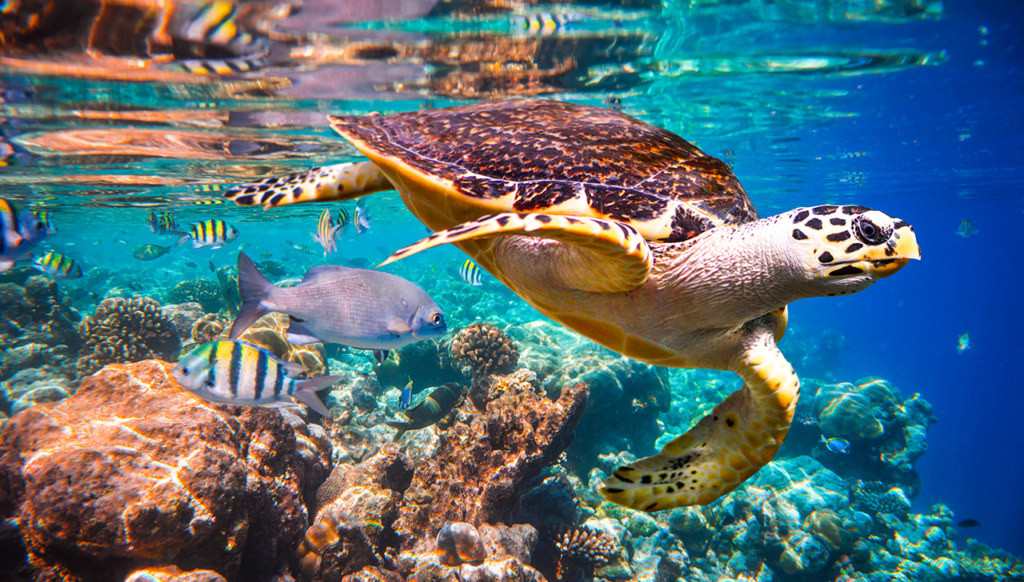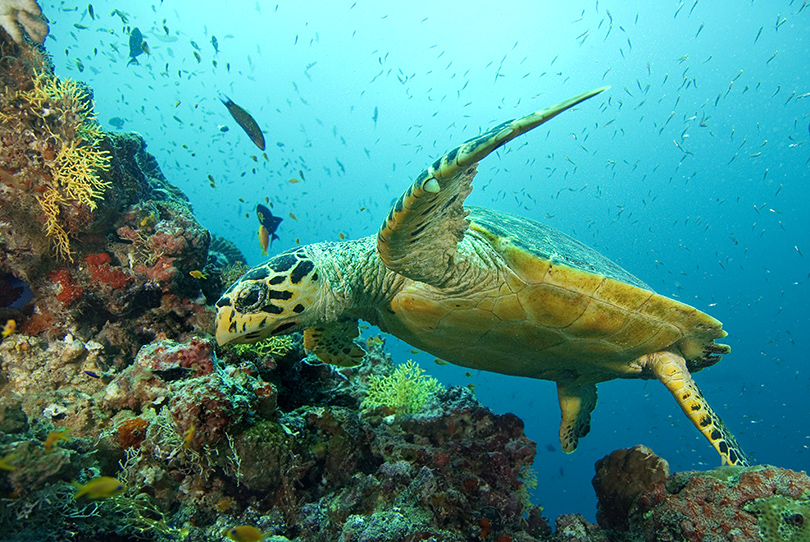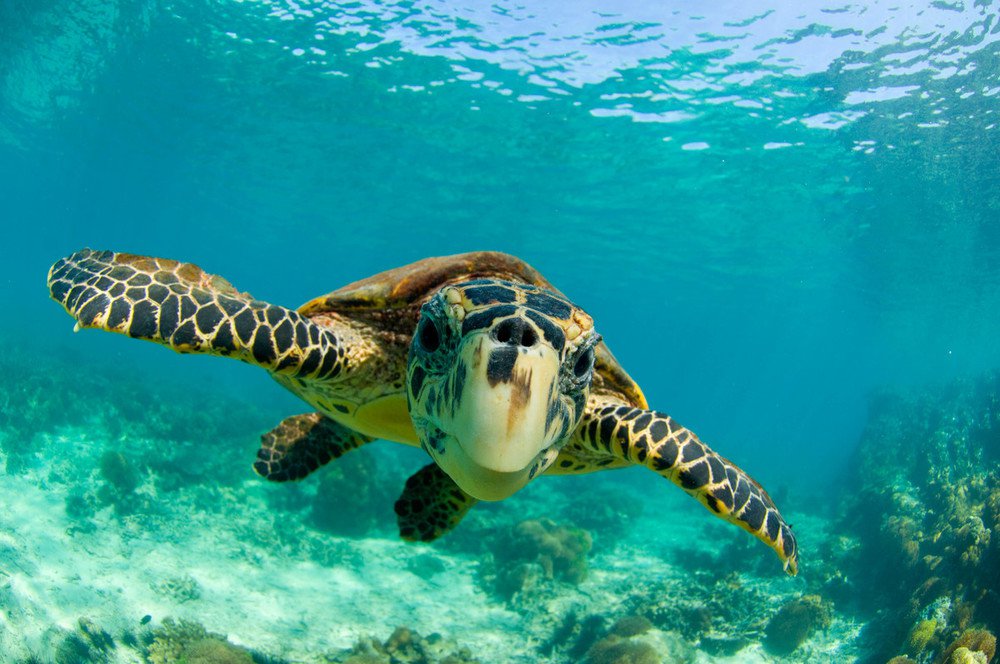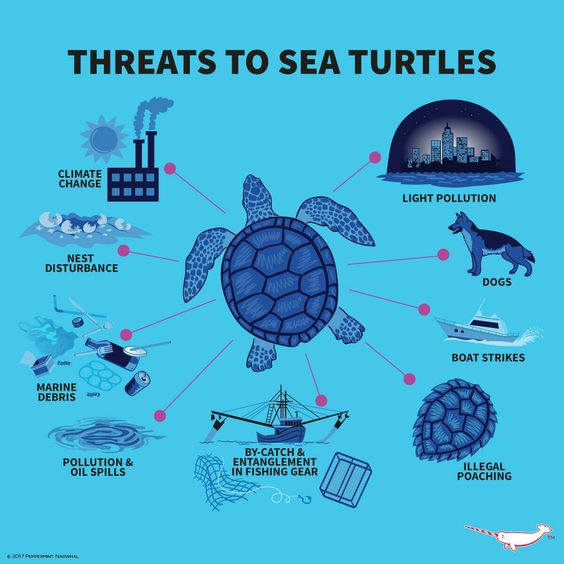Hawksbill Sea Turtle: Critically Endangered Species
The hawksbill sea turtle (Eretmochelys imbricata) is a critically endangered species of sea turtle that belongs to the family Cheloniidae.
Taxonomy:
The hawksbill sea turtle belongs to the following taxonomic classification:
- Kingdom: Animalia (animals)
- Phylum: Chordata (chordates)
- Subphylum: Vertebrata (vertebrates)
- Class: Reptilia (reptiles)
- Order: Testudines (turtles)
- Suborder: Cryptodira (side-necked turtles)
- Family: Cheloniidae (sea turtles)
- Genus: Eretmochelys
- Species: Eretmochelys imbricata

Appearance:
The hawksbill turtle is named for its distinctive beak-like mouth, which is shaped like a hawk’s bill. The carapace (upper shell) of the hawksbill turtle is highly distinctive and is composed of overlapping scutes (plates) that have a serrated or saw-like appearance. The coloration of their carapace varies, often featuring shades of brown, orange, and yellow with irregular streaks or spots.
Size:
Hawksbill sea turtles exhibit sexual dimorphism, meaning that males and females have different sizes. Here are general size ranges for adult hawksbill sea turtles:
Carapace Length:
Adult hawksbill sea turtles typically have a carapace (upper shell) length ranging from about 2 to 3 feet (60 to 90 centimeters).
Weight:
The weight of adult hawksbill turtles can vary, but they generally weigh between 100 and 150 pounds (45 to 68 kilograms) on average.

Habitat:
Hawksbill turtles are found in tropical and subtropical waters of the Atlantic, Pacific, and Indian Oceans.
They inhabit coral reefs, rocky areas, shallow coastal waters, and lagoons.
Diet:
The diet of hawksbill sea turtles is primarily composed of a variety of marine invertebrates, with a particular emphasis on certain types of sponges.
Sponges: Hawksbill turtles are notable for their specialized diet, as they feed on sponges found on coral reefs. They have a unique jaw structure that allows them to reach into crevices on the reef to extract sponges.
Other Invertebrates: While sponges make up a significant portion of their diet, hawksbill turtles also consume other marine invertebrates. This may include jellyfish, sea anemones, squid, and various types of crustaceans.
Algae and Seagrasses: Although hawksbill sea turtles are primarily carnivorous, they may consume small amounts of algae and seagrasses, especially during their early life stages.
Cnidarians: In addition to sponges, hawksbill turtles are known to eat cnidarians, which include organisms like coral polyps and hydroids.
Mollusks: Some hawksbill turtles may feed on mollusks, such as snails and bivalves, adding to the diversity of their diet.

Reproduction:
Hawksbill sea turtles reproduce through a process known as nesting. Here is an overview of their reproductive behavior:
Mating: Hawksbill sea turtles typically mate in the water. Mating behavior can be complex and may involve courtship rituals.
Nesting: The female hawksbill turtle returns to specific nesting beaches, often the same beaches where she was born. Nesting usually occurs at night, and the female crawls ashore to find a suitable nesting site.
Egg Laying: Using her hind flippers, the female digs a hole in the sand to create a nest. She then deposits a clutch of eggs into the nest. The number of eggs per clutch can vary but is typically around 100 to 150 eggs.
Covering the Nest: After laying the eggs, the female covers the nest with sand using her flippers. This helps to protect the eggs from predators and provides insulation during incubation.
Incubation: The eggs are left to incubate in the warm sand. The incubation period is temperature-dependent and usually takes several weeks.
Hatching: After the incubation period, the hatchlings emerge from the nest. Hatchling emergence typically occurs at night, and the young turtles instinctively make their way to the ocean, guided by the reflection of moonlight on the water.
Hawksbill sea turtles do not provide parental care beyond nesting. Once the eggs are laid, the female returns to the sea, and the hatchlings are left to fend for themselves.


Lifespan:
The lifespan of hawksbill sea turtles in the wild is not precisely known, as it can be challenging to track individual turtles over their entire lives. However, estimates suggest that hawksbill sea turtles can live for several decades.
In general, sea turtles have long lifespans. Many species, including the hawksbill, are known to live for 30 to 50 years or more in the wild. The exact lifespan can be influenced by various factors, including environmental conditions, predation, diseases, and human activities.
Survival rates are particularly critical during the early life stages, when hatchlings face numerous challenges from predators, natural obstacles, and human-related threats. Once they reach maturity and are less vulnerable, their chances of survival increase.

Threats:
Hawksbill sea turtles face various threats, both natural and human-induced. These threats contribute to their status as a critically endangered species.
Habitat Loss:
Destruction and alteration of nesting and feeding habitats, such as coral reefs and beaches, due to coastal development and erosion, pose a significant threat.
Climate Change:
Climate change affects sea turtle nesting sites. Rising temperatures can impact the sex ratio of hatchlings, as warmer temperatures tend to produce more female hatchlings. Changes in sea level and increased storm frequency can also affect nesting beaches.
Pollution:
Pollution, including plastic debris, oil spills, and chemical contaminants, poses a threat to hawksbill turtles. Ingesting or becoming entangled in debris can have harmful effects on their health.

Fishing Gear and Bycatch:
Hawksbill sea turtles often become accidentally entangled in fishing gear, such as trawl nets and longlines. This bycatch can lead to injury or death.
Illegal Trade:
The illegal trade of hawksbill turtle products, particularly their shells, known as “tortoiseshell,” remains a significant threat. Despite international bans on the trade of hawksbill products, it persists in some regions.
Light Pollution:
Artificial lights on nesting beaches can disorient hatchlings, leading them away from the ocean. This increases their vulnerability to predators and reduces their chances of survival.
Predation:
Eggs, hatchlings, and sometimes adult turtles face predation from various natural predators, including crabs, birds, and mammals.
Infectious Diseases:
Like many wildlife species, hawksbill sea turtles can be vulnerable to infectious diseases, which can be exacerbated by stressors such as habitat degradation and pollution.

Conservation Status:
hawksbill sea turtle (Eretmochelys imbricata) is listed as ”critically endangered” by the International Union for Conservation of Nature (IUCN) (2023). However, please note that conservation statuses can change over time as new assessments are made and more data becomes available.

Legal Protection:
Many countries and international agreements provide legal protection to hawksbill sea turtles.
The trade of hawksbill turtle products, particularly their distinctive shell known as “tortoiseshell,” is banned in many places.
Conservation efforts are ongoing to protect hawksbill sea turtles and their habitats, including initiatives focused on nesting beach protection, reducing accidental bycatch in fishing gear, and raising awareness about the importance of sea turtle conservation.

One thought on “Hawksbill Sea Turtle: Critically Endangered Species”
Wow, incredible blog layout! How long have you ever been running a blog
for? you made blogging glance easy. The entire look of your website is fantastic, as neatly as the content material!
You can see similar here ecommerce